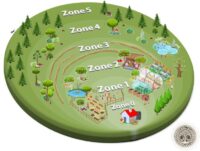Permaculture (the word, coined by Bill Mollison, is a portmanteau of permanent agriculture and permanent culture) is the conscious design and maintenance of agriculturally productive ecosystems which have the diversity, stability, and resilience of natural ecosystems. It is the harmonious integration of landscape and people — providing their food, energy, shelter, and other material and non-material needs in a sustainable way. Without permanent agriculture there is no possibility of a stable social order.
Permaculture design is a system of assembling conceptual, material, and strategic components in a pattern which functions to benefit life in all its forms.
The philosophy behind permaculture is one of working with, rather than against, nature; of protracted and thoughtful observation rather than protracted and thoughtless action; of looking at systems in all their functions, rather than asking only one yield of them; and allowing systems to demonstrate their own evolutions.

As the basis of permaculture is beneficial design, it can be added to all other ethical training and skills, and has the potential of taking a place in all human endeavors. In the broad landscape, however, permaculture concentrates on already settled areas and agricultural lands. Almost all of these need drastic rehabilitation and re-thinking.
One certain result of using our skills to integrate food supply and settlement, to catch water from our roof areas, and to place nearby a zone of fuel forest which receives wastes and supplies energy, will be to free most of the area of the globe for the rehabilitation of natural systems. These need never be looked upon as “of use to people”, except in the very broad sense of global health.
The real difference between a cultivated (designed) ecosystem, and a natural system is that the great majority of species (and biomass) in the cultivated ecology is intended for the use of humans or their livestock. We are only a small part of the total primeval or natural species assembly, and only a small part of its yields are directly available to us. But in our own gardens, almost every plant is selected to provide or support some direct yield for people. Household design relates principally to the needs of people; it is thus human-centered (anthropocentric).